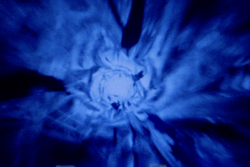 The tunnel of blue that is hyperspace travel.
Hyperspace, referred to as darkspace by the Yuuzhan Vong, represented an alternate dimension within the space-time continuum. Starships utilized it to achieve faster-than-light travel, a feat achievable solely through the use of a hyperdrive at speeds exceeding that of light. Functioning in conjunction with realspace, each specific location in realspace corresponded to a distinct point within hyperspace. Despite the fact that numerous aspects of hyperspace were still shrouded in mystery for both astrophysicists and astrogation specialists, its ability to drastically reduce travel durations was undeniable. Starships equipped with hyperdrives could traverse light-years in mere minutes. Therefore, galactic commerce, politics, warfare and galactic society as a whole depended on hyperspace travel.
The tunnel of blue that is hyperspace travel.
Hyperspace, referred to as darkspace by the Yuuzhan Vong, represented an alternate dimension within the space-time continuum. Starships utilized it to achieve faster-than-light travel, a feat achievable solely through the use of a hyperdrive at speeds exceeding that of light. Functioning in conjunction with realspace, each specific location in realspace corresponded to a distinct point within hyperspace. Despite the fact that numerous aspects of hyperspace were still shrouded in mystery for both astrophysicists and astrogation specialists, its ability to drastically reduce travel durations was undeniable. Starships equipped with hyperdrives could traverse light-years in mere minutes. Therefore, galactic commerce, politics, warfare and galactic society as a whole depended on hyperspace travel.
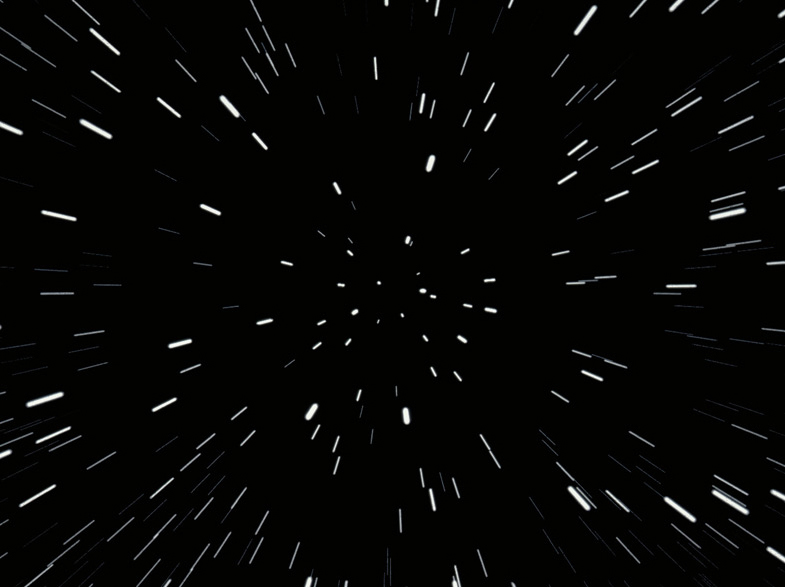
Under normal circumstances, baryonic matter within realspace is subject to the established physical laws of relativity. This means its mass escalates asymptotically as its velocity approaches the speed of light. Consequently, achieving velocities near the speed of light demands ever-increasing amounts of energy, yet the speed of light threshold remains insurmountable, even with infinite energy input. Conversely, tachyonic matter exists exclusively at speeds surpassing that of light, unable to decelerate below this light-speed threshold.
Hyperdrive technology provides a means for sentient beings to circumvent this limitation by exploiting a trans-physical phenomenon that generates spatial-temporal distortions. A vessel equipped with a hyperdrive capitalizes on these distortions to "jump" into hyperspace, facilitating its transit across the galaxy at velocities ranging from hundreds to even thousands of times the speed of light. Hyperspace constitutes an alternate dimension of space-time, akin to subspace or otherspace, which exists in conjunction with realspace. Each point in realspace corresponds to a unique point in hyperspace. In essence, a ship journeying galactic north in realspace during its transition to hyperspace would also proceed northward within hyperspace. Every entity in realspace, including planets and stars, possesses a corresponding "shadow" in hyperspace situated at the same location it occupies in realspace.
The ancient Rakata were the first to discover the principles behind Hyperspace travel.
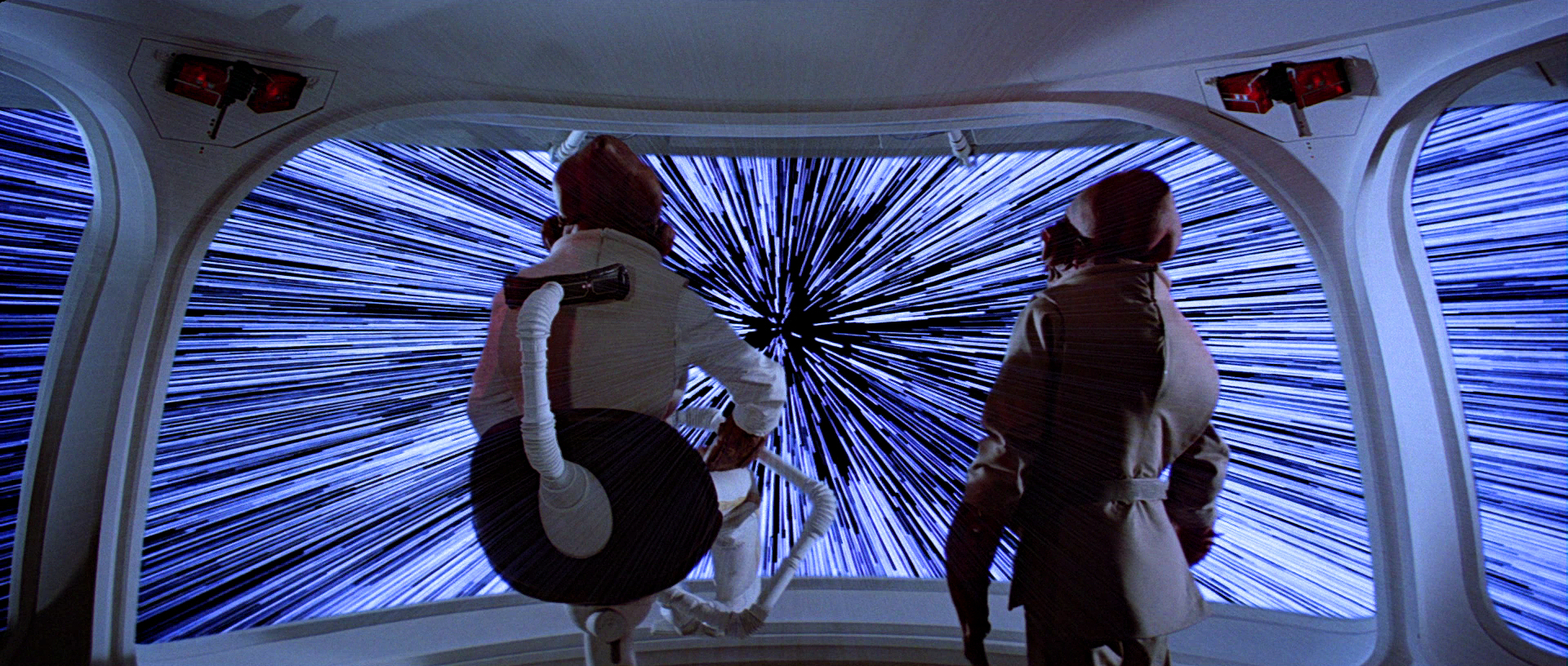
The employment of a hyperdrive by a starship necessitated adherence to a standardized, methodical procedure. After the desired trajectory was programmed into the navigation computer, the vessel aligned itself with the designated course and initiated the hyperdrive. Subsequently, the ship appeared to accelerate at an extraordinary rate, causing passengers to perceive the stars as elongated, parallel streaks during the "jump" into Hyperspace. This perceived acceleration was also discernible externally, where a ship transitioning to Hyperspace exhibited a sudden, pronounced surge in velocity before vanishing from the conventional universe. This occurrence was termed pseudomotion.
Upon entering hyperspace, the starship effectively departed from the conventional universe, or realspace. At hyperspeed, the entire observable universe manifested as a blue-tinted corridor characterized by blurred motion, indicative of Hyperspace's other-dimensional nature. Within Hyperspace, a ship was essentially isolated from all conventional methods of scanning and detection.
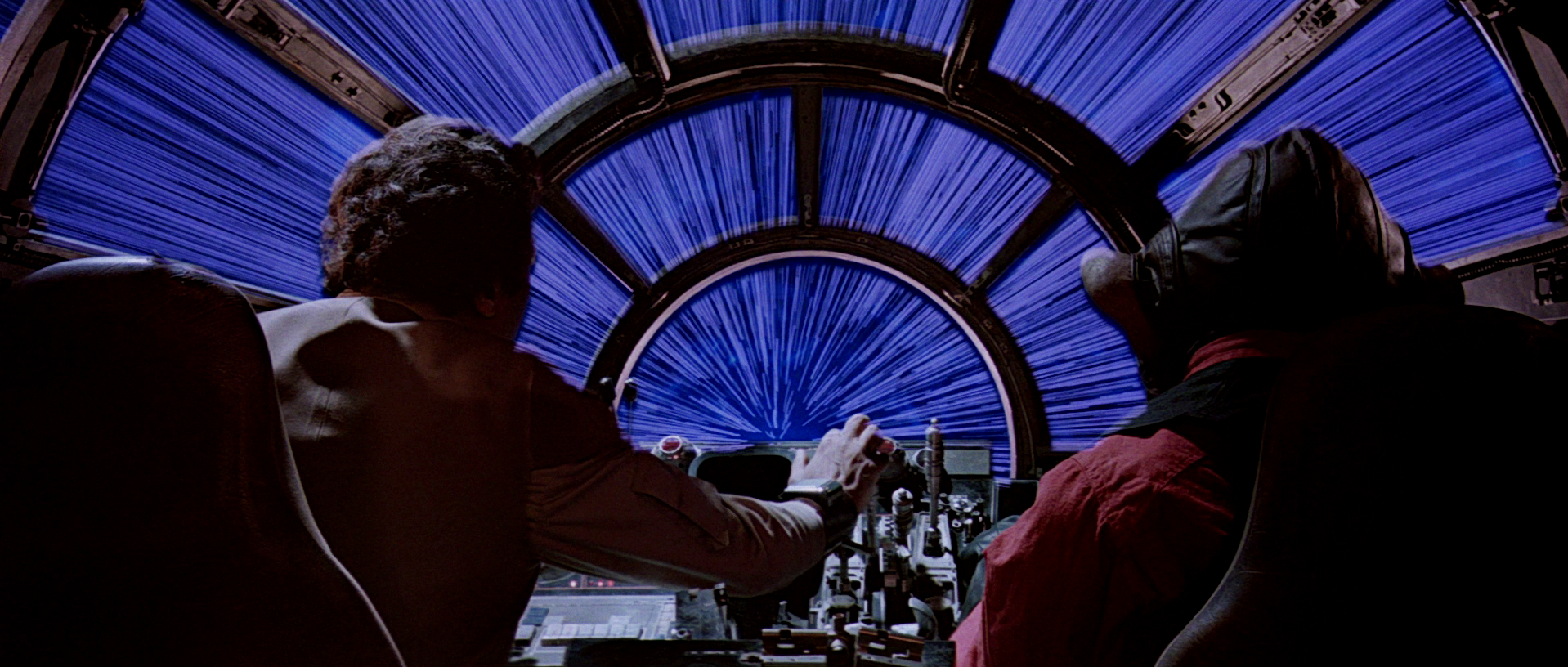
Executing a hyperdrive jump with a ship, such as the T-65 X-wing starfighter, involved inputting coordinates into a navicomputer, either through manual entry or via wireless transmissions. Rogue Squadron, among numerous others, utilized this method to ensure all ships within a group or fleet employed identical coordinates for a given mission. Coordinate calculation posed a significant risk, as any vessel traversing hyperspace too closely to a black hole, star, or other substantial gravitational source risked being forcibly ejected from hyperspace. Intrasystem hyperspace travel via "micro-jumps" was infrequent but occasionally employed strategically.
Due to the inherent perils of hyperspatial navigation, frequently used routes tended to be located near inhabited systems. In the event of a navigational error or hyperdrive malfunction, the proximity of starports or populated systems lessened the likelihood of being stranded with only sublight propulsion and limited provisions. Typically, issues arose from inaccuracies in calculating navigation coordinates or from incomplete and outdated information pertaining to significant gravitic bodies. Locating a ship that had re-entered realspace due to a malfunction or at an unknown location proved to be a nearly insurmountable task, as evidenced by the protracted search for the legendary Katana fleet across the vast expanses of open space.
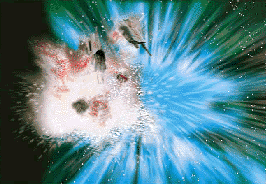
Traveling at speeds many times the speed of light presented numerous hazards. While any form of collision or interference during hyperspace travel could be potentially lethal, the gravitational influence on a starship could be particularly catastrophic. Consequently, courses had to be plotted to avoid the "mass shadow" or gravitational well of large celestial bodies. This vulnerability was exploited in various ways throughout history. Hyperspace courses were commonly plotted utilizing a planet's mass as a backstop, with the hyperdrive's safety mechanisms automatically halting the ship upon reaching the farthest extent of permissible travel.
Hyperspace collisions, whether intentional or accidental, had the potential to devastate or even obliterate a planet. Given that the energy output of the reactors aboard many Capital ships rivaled or exceeded that of a star, and considering the immense energies required to facilitate hyperspace travel, a considerable amount of destructive force could be unleashed upon a target. Even if a planet possessed operational planetary shielding at the time of a hyperspace collision, the resulting fallout could still lead to millions of fatalities on a world such as Coruscant. One notable hyperspace incident occurred during the Clone Wars, involving the battlecruiser Quaestor, which collided with the Separatist planet Pammant, causing it to fracture to its core.
Gravity generators could be employed to generate an artificial interdiction field, effectively halting hyperspace travel within a designated area. This field replicated the gravitational fringes of a celestial body, enabling the interception of ships en route through hyperspace and preventing adversaries from escaping to lightspeed during combat. Less affluent groups, such as pirates, resorted to dragging sizable asteroids (or planetoids) into trade routes as an alternative to generators or starships. This provided them with a means to halt shipping and a temporary base or shield against enemy fire.
Black holes posed a persistent threat. Each year, several vessels were lost due to the presence of "wandering" black holes in real space. Their virtually infinite gravitational wells could prove catastrophic to any craft that strayed too close.
Beyond the protection of a vessel's shielding, hyperspace itself presented a lethal environment to any realspace species. Being ejected from the airlock of a ship while in hyperspace proved to be a more effective means of eliminating an individual than exposing them to the vacuum of realspace. While survival was possible within an escape pod ejected into hyperspace, reversion to realspace would be impossible if the pod lacked its own hyperdrive.
Even prolonged observation of hyperspace from a starship's observation deck could induce "hyper-rapture," a form of insanity, according to legends. Due to the perceived inherent anomaly in viewing the higher-dimensional universe, standard Imperial operating procedure mandated that transparisteel be opaqued during hyperspace travel. However, Darth Vader derived pleasure from observing the kaleidoscopic and swirling patterns of light, while Cronal found solace in contemplating what he perceived as the emptiness beyond the universe.
When a jump was attempted with a hyperdrive that was damaged, a starship could become trapped in a spatial "crossroad," existing partially in hyperspace and partially in realspace. An example of this was the Sith dreadnaught Harbinger. Through the quick thinking of the ship's captain, Saes Rrogon, the ill-fated vessel was propelled 5,000 years into the future, arriving in the era of Luke Skywalker's Jedi Order.
In addition to navigational dangers, communicating with a starship traveling at hyperspeed presented inherent difficulties. Since ships in hyperspace did not exist in a conventional sense, they were largely isolated from conventional radio or subspace communication, as signal wavelengths would undergo significant distortion, even if they reached the vessel. Hypercomm signals could reach a vessel in hyperspace, but communication in this manner was challenging unless the signal originated from either end of the ship's trajectory or between ships traveling on the same course.
The same challenges that communication faced also affected sensors. Maintaining sensor lock on a vessel in hyperspace proved nearly impossible, making escape to lightspeed a reliable tactic in most engagements. Pursuit was generally limited to plotting several courses along the target's last known vector and attempting to predict where the ship would re-emerge from hyperspace for course corrections. This strategy was typically unsuccessful, as most ships seeking to evade pursuit would execute a brief jump followed by a longer one to a different vector before enemies could arrive. The most effective approach involved placing a homing beacon on the enemy ship, but at long distances, only HoloNet-equipped tracking devices were effective, and these were prohibitively expensive.
An intriguing phenomenon associated with hyperspace travel was Cronau radiation. This involved a brief but potent burst of radiation emitted when a ship entered or exited hyperspace. Properly aligned sensors could detect this radiation from a few light-seconds away, often beyond the normal sensor range. This enabled the Rebel base on Hoth to prepare for the impending attack when Admiral Ozzel mistakenly brought the Executor and its battle fleet out of hyperspace too close to the system, rather than approaching stealthily from outside the system.
While hyperspace travel represented the primary application of this phenomenon that unified the modern galaxy, it was not the sole one. Hypercomm technology facilitated the transmission of signal packets through hyperspace at greater speeds and distances than conventional subspace transmitters, and it did so with greater speed than hyperdrive-equipped starships. The HoloNet further extended this range, utilizing an interconnected network of hyperwave transceivers suspended in hyperspace to rebroadcast vast amounts of data across the galaxy. This enabled instantaneous, full-holo transmissions from virtually any subscriber to any other. Under the Galactic Empire, the HoloNet was subject to strict control. Even under the New Republic, maintaining the network remained prohibitively expensive, limiting direct two-way connections primarily to government personnel and the wealthy. However, news, entertainment, and other widespread broadcasts were transmitted throughout the galaxy and repeated on local sector-based subspace networks, ensuring that every level of galactic society was affected by this communications tool, not just those with expensive hypercomm systems.
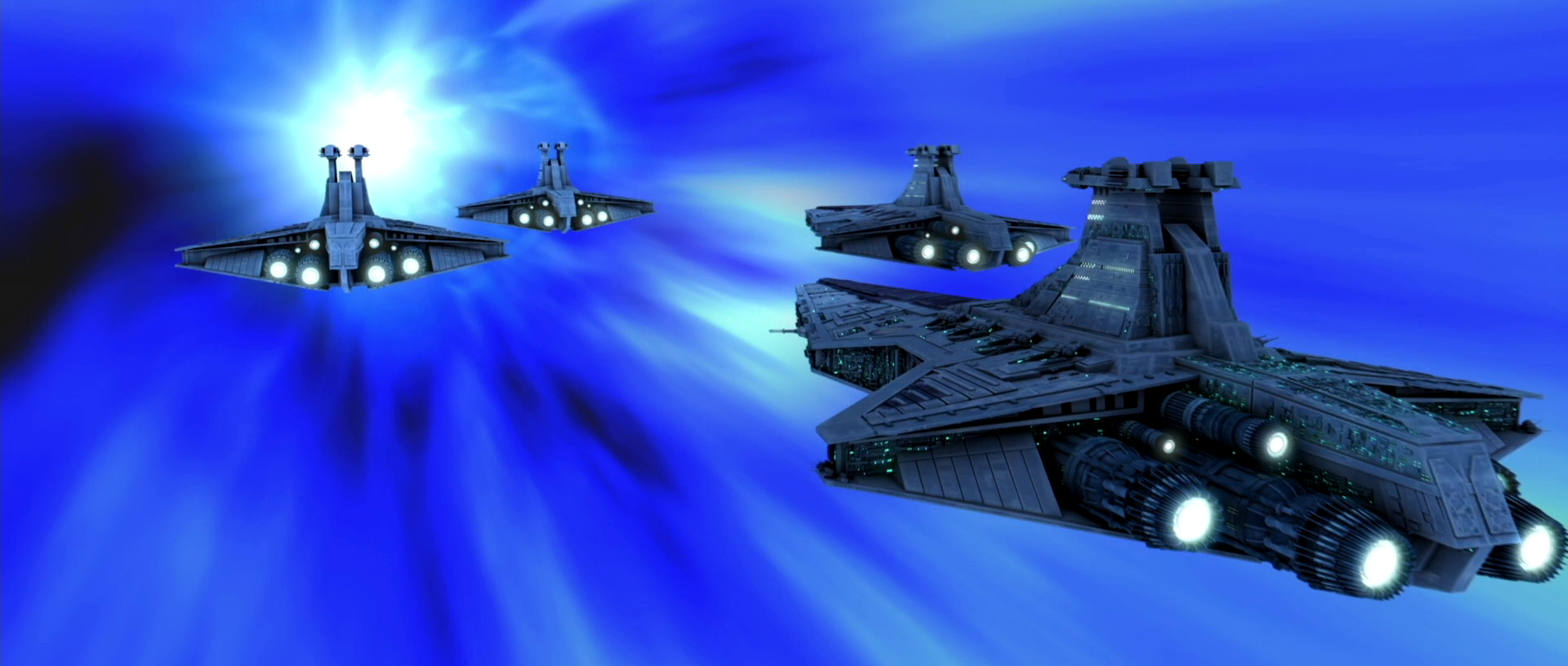
Due to the threat posed by mass shadows (and interdicting pirates), hyperspace courses had to be plotted with meticulous care. Few beings other than powerful Jedi could react while traveling at many times the speed of light. In any case, conventional sensors and communicators were unable to receive information faster than lightspeed. Even subspace sensors, which operated within an alternate dimension and propagated faster than light, could not keep pace with the immense speeds of hyperspace travel. Thus, accurate advance knowledge of the celestial bodies along the route was essential, necessitating the use of navigational computers. These devices, also known as nav comps or navicomputers by spacers, contained detailed star charts and the ability to perform astronavigational calculations rapidly from one point to another before a jump was initiated.
While pilots required a fundamental understanding of astronavigational skills to operate a nav computer effectively, they did not need to comprehend the intricate physical equations governing hyperspeed travel. However, certain species, such as the Givin and Siniteen, possessed the innate ability to calculate these equations mentally, obviating the need for computer assistance. The internal library charts required periodic updates, as systems slowly shifted within the galaxy, stars underwent explosive events or were born, and so on. Consequently, a dedicated corps of explorers and cartographers persisted millennia after the initial charting of star lanes.
The majority of star travelers utilized pre-existing, well-established trade routes. This ensured that interdiction by pirates and encounters with celestial bodies were minimized, assistance was readily available in the event of a malfunction, and travel times could be reasonably predicted.
The Hound's Tooth, the personal vessel of the bounty hunter Bossk, possessed the ability to alter course mid-hyperspace jump. Flirt deemed this capability "magnificent" when examining the ship's systems during a return trip to Lomabu.
Due to the existence of hyperspace shadows, there was also no direct, fixed hyperspace route that connected opposite ends of the galaxy.
Despite the maturity of the technology and the constant updating of relatively stable hyperspace routes, navigating through hyperspace remained a hazardous undertaking. While generally determined by the distance separating two planets, hyperspace travel times between seemingly proximate locations could be significantly extended by the necessity of circumventing stellar hazards, such as asteroid fields and nebulae.
An example of this was the journey between Coruscant and Alderaan. In terms of distance, Alderaan was situated close to Coruscant—the former approximately 5,000 light years from the Core, the latter approximately 10,000. However, during the Imperial era, such a journey required roughly sixteen hours of travel due to a section of the route passing through a part of the largely-uncharted Deep Core, where navigation was difficult as a result of the gravity wells produced by the congregation of stars. Ironically, then, it was actually faster to get from Tatooine to Alderaan on the other side of the galaxy. In some cases, intragalactic travels could take days, depending on the distance between two planets and the obstacles between.